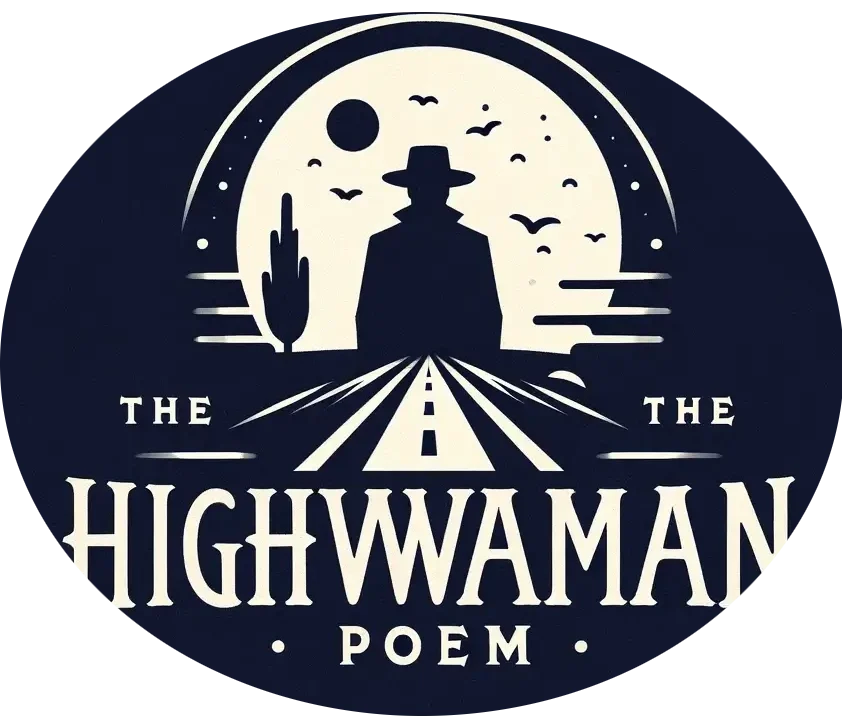Alfred Noyes’ “The Highwayman” stands as a classic poem renowned for its adept use of figurative language, particularly metaphors.
This article aims to thoroughly examine the principal metaphors employed by Noyes, elucidate the symbolism underpinning them, and assess their influence on the poem’s thematic essence.
Through a comparative analysis of these metaphors with those found in other poetic works, a more profound comprehension of Noyes’ distinctive stylistic approach can be attained.
Readers are invited to partake in an exploration of the significance of metaphors in “The Highwayman” and to contextualize them within their historical milieu.
Metaphors In The Highwayman Poem and Key Takeaways:
- Metaphors are powerful tools that add depth and emotion to poetry, as seen in Noyes’ The Highwayman.
- The use of metaphors in The Highwayman helps to convey themes of love, sacrifice, and betrayal in a vivid and captivating manner.
- Noyes’ clever and intricate metaphors not only add to the poem’s beauty but also provide insights into the historical and cultural context in which it was written.
Understanding Figurative Language in Poetry
The utilization of figurative language in poetry, such as metaphors, similes, and imagery, constitutes a potent mechanism for conveying intricate emotions and vibrant imagery, thereby augmenting the reader’s engagement with the text.
Metaphors, by establishing connections between two ostensibly dissimilar entities, introduce layers of significance to poetry. For instance, when a poet likens a heart to a delicate glass ornament, the reader not only envisions fragility but also apprehends the emotional vulnerability imbued in the analogy. In contrast, similes employ the usage of ‘like’ or ‘as’ to draw comparisons, thereby animating vivid depictions. Additionally, imagery, facilitated through sensory delineations, crafts a comprehensive visual in the reader’s imagination, eliciting sentiments and perceptions that enrich the overall essence of the poem.
Analysis of Metaphors in The Highwayman
Alfred Noyes utilizes a variety of metaphors in ‘The Highwayman‘ to amplify the emotional depth and vivid imagery of the poem, establishing a more profound connection between the reader and the narrative.
Key Metaphors Used by Alfred Noyes
The use of key metaphors in ‘The Highwayman,’ such as the ‘ghostly galleon‘ and the ‘French cocked-hat‘ in the moonlight, is notable for their vivid imagery and symbolic depth. The depiction of the ‘ghostly galleon’ adds an element of mystery and foreboding to the poem, drawing a parallel between the highwayman’s approach and that of a spectral ship traversing the night. This metaphor not only underscores the daring and adventurous qualities of the highwayman but also suggests the perils and hazards he encounters in his endeavors.
Similarly, the reference to the ‘French cocked-hat’ conveys connotations of authority and prestige, creating a stark contrast with the romanticized outlaw image of the highwayman and accentuating the themes of class distinctions and societal norms within the narrative.
Exploring the Symbolism Behind Metaphors
The metaphors employed in ‘The Highwayman,’ such as the ‘gypsy’s ribbon‘ and ‘red coats,’ serve as symbolic elements that enrich the poem by intertwining themes of love, death, and sacrifice.
These metaphors function as potent vehicles through which the poet conveys profound sentiments and broader societal concerns. The ‘gypsy’s ribbon’ is emblematic of the enduring bond between the highwayman and Bess, illustrating the timeless nature of their love despite the social barriers and circumstances that separate them. Conversely, the foreboding image of the ‘red coats’ not only signifies the oppressive forces of authority but also underscores the inevitability of sacrifices made in the pursuit of justice and freedom. Each metaphor vividly captures the imagination of the audience, eliciting a range of emotions and prompting deep contemplation.
Impact of Metaphors on the Poem’s Theme
The application of metaphors plays a pivotal role in shaping the central themes of ‘The Highwayman,’ particularly by accentuating the tragic and romantic elements that contribute to its somber and atmospheric ambiance.
These metaphors, such as the comparison of the love shared between Bess and the highwayman to celestial bodies like the moon and stars, effectively heighten the themes of yearning and sacrificial love within the narrative. The recurrent imagery of the red-coated soldiers being likened to spectral figures haunting the inn further intensifies the eerie quality of the poem, symbolizing the relentless pursuit that culminates in a tragic outcome.
Through these vivid analogies, the poem conveys a sense of predestined fate and inevitability, presenting a portrayal of love that transcends temporal and spatial boundaries, even in the face of dire repercussions.
Comparative Analysis with Other Poems
When comparing ‘The Highwayman’ with other poems, one can observe the distinctive and effective use of metaphors and figurative language by Alfred Noyes. This sets the poem apart in terms of its emotional depth and narrative style.
Contrasting Metaphors in Different Poems
Examining the metaphors utilized in ‘The Highwayman’ in comparison to those found in other poems unveils specific literary devices and thematic emphases distinct to each piece of work.
In ‘The Highwayman,’ the metaphor of the clopping hooves serves to signify imminent peril and tension, fostering a sense of urgency throughout the narrative. This stands in contrast to the metaphor of the rose in ‘The Sick Rose‘ by William Blake, in which the flower embodies innocence tainted by experience. Through an exploration of these divergent metaphors, readers can acquire a more profound comprehension of how various poets employ symbolic language to communicate their messages and themes in varied manners.
Similarities in Figurative Language Across Poems
Despite variations in themes and styles, numerous poems demonstrate commonalities in their utilization of figurative language, incorporating techniques such as metaphors, similes, and imagery to enhance their narratives.
These literary devices not only serve as adornments but also function as potent instruments to elicit emotions and construct vivid imagery in the minds of readers. Metaphors, for example, have the capacity to convey intricate concepts in a straightforward and relatable manner, while similes aid in establishing connections between apparently disparate ideas. Through the use of imagery, poets craft intricate scenes that immerse the audience in the world of the poem, enabling them to vicariously encounter the emotions and scenarios portrayed.
By employing these shared techniques, poets spanning various works can effectively convey their messages and leave enduring impressions on their readers.
Interpreting Noyes’ Metaphors
Analyzing Alfred Noyes’ incorporation of metaphors in ‘The Highwayman’ entails diving into the intricate nuances and emotional depth that these figurative expressions imbue the poem with.
Unraveling the Deeper Meanings
The exploration of the metaphors in ‘The Highwayman’ provides profound insights into themes such as love, sacrifice, and the inevitability of death.
The depiction of the highwayman as a symbol of unwavering dedication and bravery underscores the extreme lengths individuals may undertake in the name of love, even at the expense of their own lives. The interweaving of destiny in the winds and the haunting presence of the highwayman’s spirit in the inn suggests that love and tragedy are intertwined, accentuating the poignant nature of human emotions.
By employing the metaphor of the red-coated soldiers and their act of treachery, the poem scrutinizes concepts of loyalty and betrayal, presenting the intricate dynamics of human relationships amidst challenges.
Connecting Metaphors to Historical Context
The analysis of the metaphors within ‘The Highwayman’ within the framework of its historical context, which includes allusions to King George and England, serves to enhance the reader’s understanding of the poem’s setting and multifaceted narrative.
The depiction of King George as a character within the poem symbolically represents the pervasive power and authoritarianism characteristic of that particular period, thereby reflecting the prevailing political conditions of the time. Furthermore, the detailed portrayals of the highwayman’s cloak and the innkeeper’s daughter serve to underscore the pronounced societal divisions that were prevalent in 18th-century England. By closely examining these specific allusions, readers can gain insight into the underlying tensions between various social classes and the perpetual struggle for autonomy and justice. This critical evaluation enables a comprehensive exploration of the societal norms and adversities encountered by individuals within that historical epoch, consequently amplifying the overarching impact and significance of the poem.
Frequently Asked Questions
1. How does Noyes use metaphors in “The Highwayman” poem?
Noyes uses metaphors throughout the poem to create vivid imagery and convey deeper meanings. For example, the highwayman is compared to a “ghost” and “nightmare” to highlight his dangerous and mysterious nature.
2. What are some examples of metaphors in “The Highwayman” poem?
Some examples of metaphors in the poem include the highwayman being compared to a “phantom” and “shadow” and Bess being compared to a “rose” and a “lily.”
3. How does Noyes’ use of figurative language enhance the overall meaning of the poem?
Noyes’ use of metaphors adds depth to the poem by giving symbolic meaning to the characters and their actions. It also helps to create a sense of suspense and emotion for the reader.
4. What is the significance of Bess’ metaphorical comparison to a “rose” and a “lily” in the poem?
Bess’ comparison to a “rose” and a “lily” represents her beauty, innocence, and purity. It also foreshadows her tragic fate, as roses and lilies are often associated with death and mourning.
5. Are there any other literary devices used in “The Highwayman” besides metaphors?
Yes, there are also examples of alliteration, assonance, and onomatopoeia in the poem. These devices help to create a musical quality to the poem and add to its overall impact.
6. How has “The Highwayman” poem been interpreted by different sources?
“The Highwayman” has been analyzed and interpreted in various ways, with some viewing it as a love story, while others see it as a tragedy or a commentary on social injustice. It has also been adapted into plays, films, and other forms of media.

